Maneuver Warfare Roadmap: Part II: Concepts of Employment & Tactical Applications
Posted on July 22,2019Article Date May 01, 1982
by Col Bruce G. Brown, USMC(Ret)
Part 1 of this article was published last month. In it the author discussed how amphibious doctrine must change if we are serious about adopting the basic concepts of maneuver warfare. He then identified six structural/organizational trends that must accompany a transition of this kind: In brief, he believes the Corps will have to break with mirror image infantry battalions and organize its ground combat elements in three different forms-light, foot-mobile infantry, tight armored forces, and heavier mechanized combined arms forces. He sees a new emphasis on heavy-lift helicopters (a trend already begun by the acquisition of M198 artillery), a need for new command relationships with helicopters, and a seabasing logistics concept. In this article he continues his analysis describing how an amphibious landing force might be organized for maneuver warfare and presenting examples of how it might conduct operations.
Task Organization of Landing Forces
Concepts of employment and tactical applications are inevitably linked to the capabilities of the amphibious task force (ATF) and its component landing force (LF). The LF component, a Marine air ground task force (MAGTF), may range in size from a MAU to a MAF. The basic concept of task organizing the LF is sound and should remain constant. However, what should change is the perception and application of the doctrine. The problem is that the doctrine is the essence of flexibility while applications have been stereotyped. Requirement documents such as the Marine Corps mid-range objective plan (MMROP) present notional MAU, MAB, and MAF troop lists (i.e., one list for each “representative” MAGTF). Prior to publication of the Commandant’s White Letter 1-80 and the assumption of Rapid Deployment Joint Task Force (RDJTF) tasking, contingency planning was based on the basic assumption that MAFs would deploy as organizational entities. Both of these examples portray stereotype MAGTF task organization.
Now there is a new ballgame called the “composite MAF.” It provides an opportunity for the Marine Corps to demonstrate the flexibility of its doctrine. MAGTFs can be tailored (sized and task organized) for the specific contingencies they are tasked to support by drawing from the assets of all three MAFs. Equally important, requirements documents can reflect the wide range and differences represented by these contingencies through the use of several representative troop lists at each MAGTF level.
In order to illustrate the difference in perception and application, let’s look at the MAF exclusively. First, assume that each of the three ground combat trends identified in Part I results in a minimum of two regiments in the total force structure; i.e., two mechanized combined arms task forces (MCATFs), two light armored task forces (LATFs), and two foot-mobile infantry commands. Also assume that all six of these reinforced regiments are available to deploy in an amphibious mode. Given these assumptions, the flexibility of the basic doctrine can be illustrated by the following description of the MAF-level forcible entry capability.
The MAF
The MAF is built around two to four RLTs and a task organized aircraft wing. The smallest MAF contains five BLTs. The largest MAF configured for seaborne forcible entry operations could contain 12 BLTs and 2 tank battalions-this upper limit set by anticipated amphibious shipping constraints.
The MAF can be task organized in a wide variety of ways to meet the terrain conditions and anticipated threats associated with specific contingency tasks. For example, the largest and heaviest MAF could contain two heavy MCATF RLTs and two LATF RLTs. The maneuver warfare potential of this MAF in suitable terrain far exceeds the sum of its parts. In areas where restricted terrain is the dominant characteristic, a MAF containing two foot-mobile infantry RLTs and one or two LATF RLTs also has exceptional maneuver warfare potential.
For purposes of this article, a MAF containing one heavy MCATF, one LATF, and one foot-mobile infantry RLT will be used as the illustrative example.
General Concept of Employment
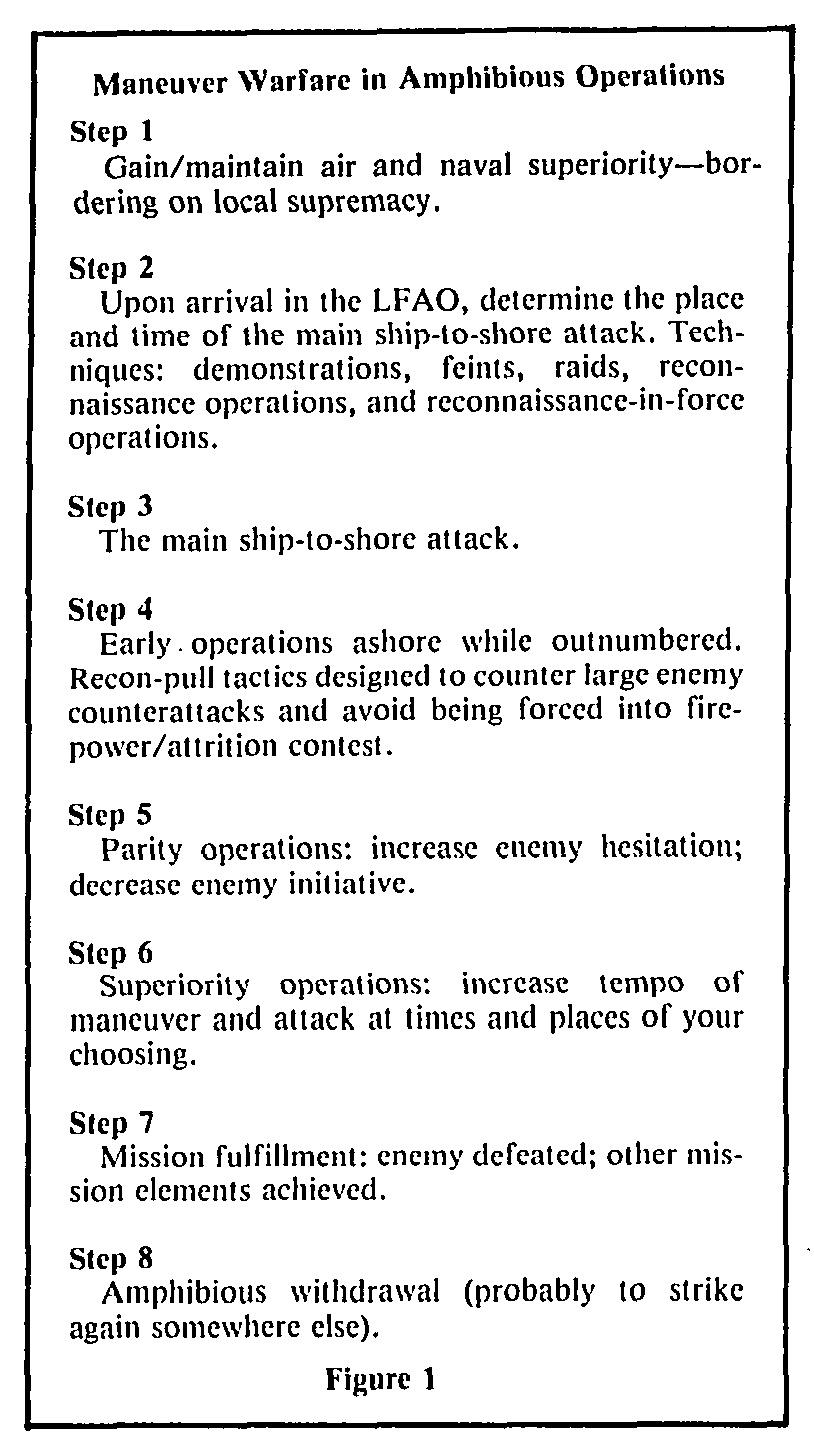
The overall concept of employment involves seaborne forcible entry and a maneuver style of warfare ashore while seabased. Focus is on defeating a numerically superior tank-heavy mechanized force on terrain that is largely unrestricted and on gaining control of the operational area. There appear to be eight definable steps (Figure 1) implicit in such operations. A brief discussion of each step follows:
* Step 1-Gain and maintain air and naval superiority. Although this remains a fundamental part of doctrine, tactics may be much different if the enemy force is numerically superior in either category, or if a situation of approximate parity exists at the time the initial engagement commences. A multipurpose ATF would, as feasible, directly assist other naval forces in achieving the necessary air and naval superiority.
* Step 2-Determine the place and time of the main ship-to-shore attack. Use of demonstrations, feints, raids, covert reconnaissance, and overt reconnaissance-in-force operations ashore would be used in almost all seaborne forcible entry operations. These operations would seek to gain detailed information, and perhaps deceive or confuse the enemy as to when and where the main attack will strike. However, the primary purposes are to ensure accurate knowledge of the strength and weaknesses of the enemy defense and test enemy reactions.
* Step 3-The main ship-to-shore attack. The main attack is fundamentally characterized by the landing of the heavy (nonhelicopter-transportable) MCATF. Because the MCATF is very difficult to extract once it is committed ashore, its landing signals a main attack and the intention to maneuver ashore indefinitely.
*Step 4-Early operations ashore while outnumbered. An understanding of this step is critical to the survival of the landing force. A numerically superior enemy with heavy tank and mechanized forces will surely understand (as his doctrine clearly indicates) that his best chance of defeating a landing is through large-scale, early counterattacks. Therefore, during this step, recon-pull tactics are used to ensure that the landing force is not trapped into a firepower-attrition contest nor defeated piecemeal. The principle of security is emphasized in coordination with maneuver.
* Step 5-Parity operations. When approximate parity exists between forces, the immediate goal should be to increase enemy hesitation and decrease his initiative. Parity does not mean that the enemy’s “cohesion has been shattered” or even seriously impaired. Also, remember that although a senior enemy commander may be or may appear to be confused, his tactical units and smaller commands will follow orders loyally and fight with intense determination. History shows that such behavior sometimes turns apparent defeat into victory.
* Step 6-Superiority operations. Obviously, this condition permits an increase in the tempo of maneuver and attack at times and places of your choosing. However, defeat of the enemy is through focus on his vulnerabilities rather than on one “grand, command-push attack.”
* Step 7-Mission fulfillment. Once the enemy has been defeated, other explicit or implicit elements of the mission can then be accomplished. This could include continuing control of the landing force area of operations (LFAO) for an indefinite time, conduct of ground and air interdiction operations, or reconnaissance-in-force operations.
* Step 8-Amphibious withdrawal. This step is designed to imply that the best use of landing forces in a maneuver style of warfare is as a continuing component of an ATF-an ATF supporting the naval aspects of a joint campaign. It does not mean that landing forces would never be committed to sustained land combat, only that such commitment should not be viewed as the doctrinal norm.
Sample Concepts of Employment/Tactical Applications
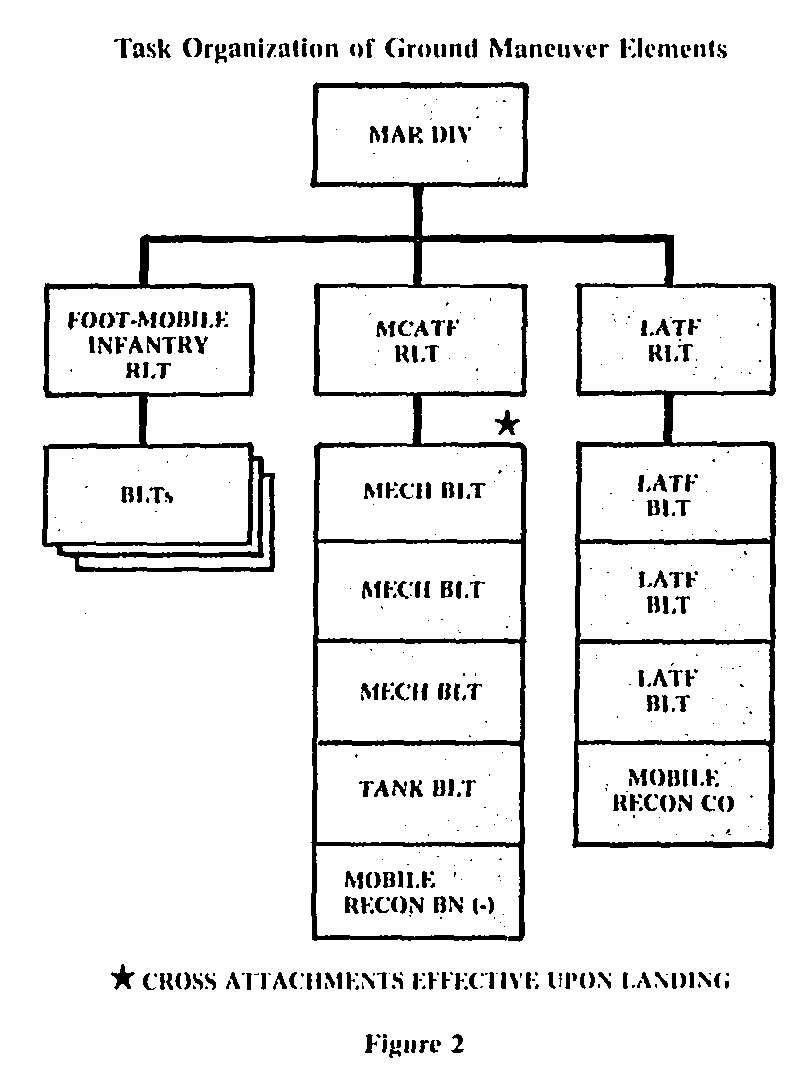
The examples presented below are based on the ground maneuver elements of a reinforced division task organized as shown in Figure 2. They focus exclusively on the ground maneuver elements in order to simplify the presentation. Also, it will be assumed that a CH-53E type helicopter is the primary transport helicopter of the landing force, and that the numbers (estimated ‘to be 85-95) are sufficient to transport the scheduled serials of one LATF BLT in one lift. Such numbers would also be sufficient to transport 2,700-3,000 foot-mobile infantry Marines in one lift-a figure estimated to equate to the entire foot-mobile RLT. In addition, the ATF is assumed to contain 70 landing craft air cushion (LCAC) vehicles, sufficient to transport all tanks of one tank battalion in one lift, or the scheduled serials of an entire LATF or foot-mobile infantry RLT.
The first example illustrates reconnaissancein-force applications related to step 2, determination of the time and place for the main ship-to-shore attack. (See Figure 3.) This illustration portrays the flexible options provided by the lighter RLTs in conjunction with the heavy-lift helicopter and LCAC. Repeated overt reconnaissance insertions/extractions and reconnaissance-in-force attacks/extractions could lead to a reconnaissance-in-force operation without a predetermined extraction. In such case, the commanders would have the option of landing the heavy MCATF in lieu of extracting the reconnaissance-in-force elements; i.e., recon-pull of the main ship-toshore attack.
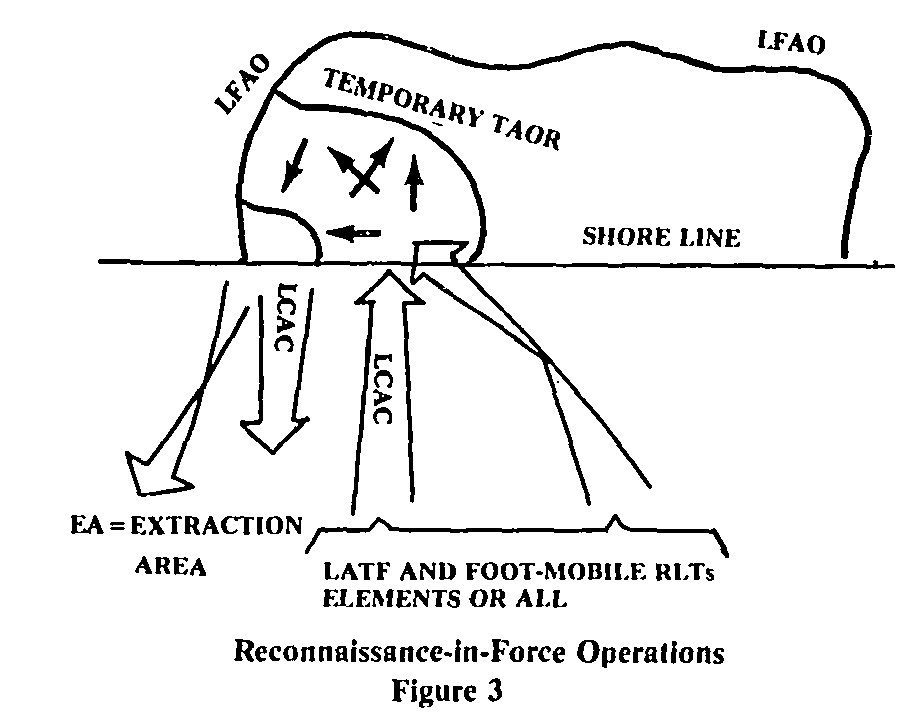
In most cases, however, it is believed the main ship-to-shore attack would be a coordinated command-push operation in an area containing an undefended or lightly defended surface landing site (i.e., a portion of the shoreline where AAVs and LCAC can land). Before illustrating the main attack, it is useful to keep in mind that throughout step 2 operations and at the commencement of the main attack, the ATF is maneuvering to pose a threat to land anywhere in the LFAO (Figure 4).
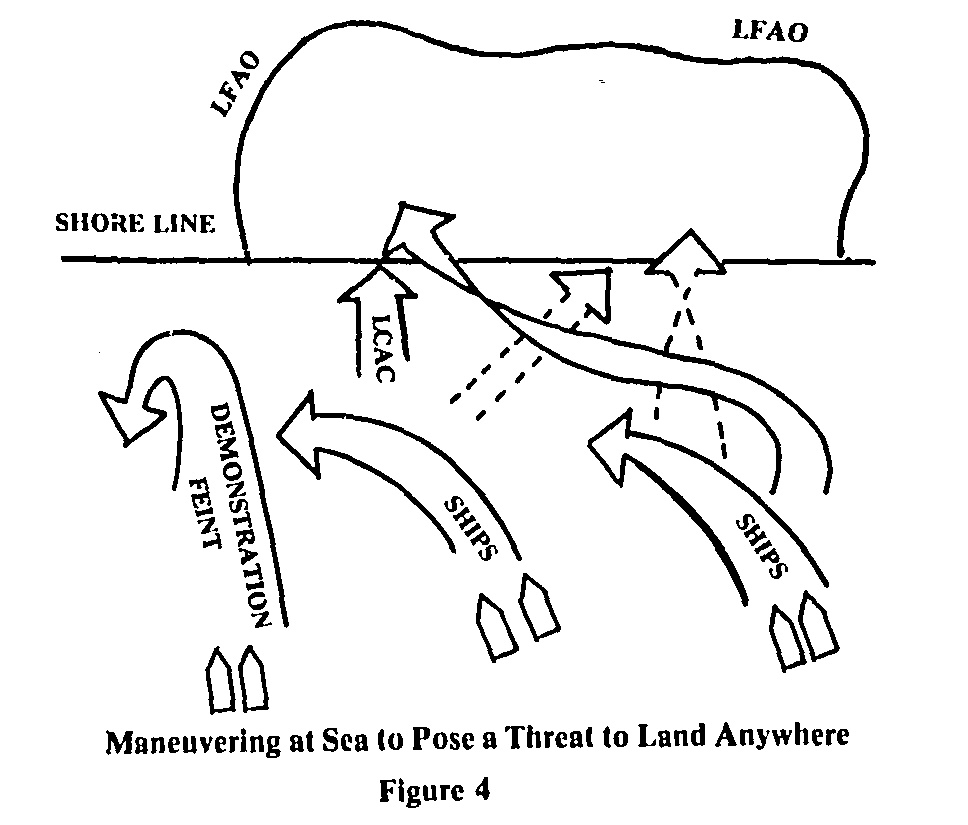
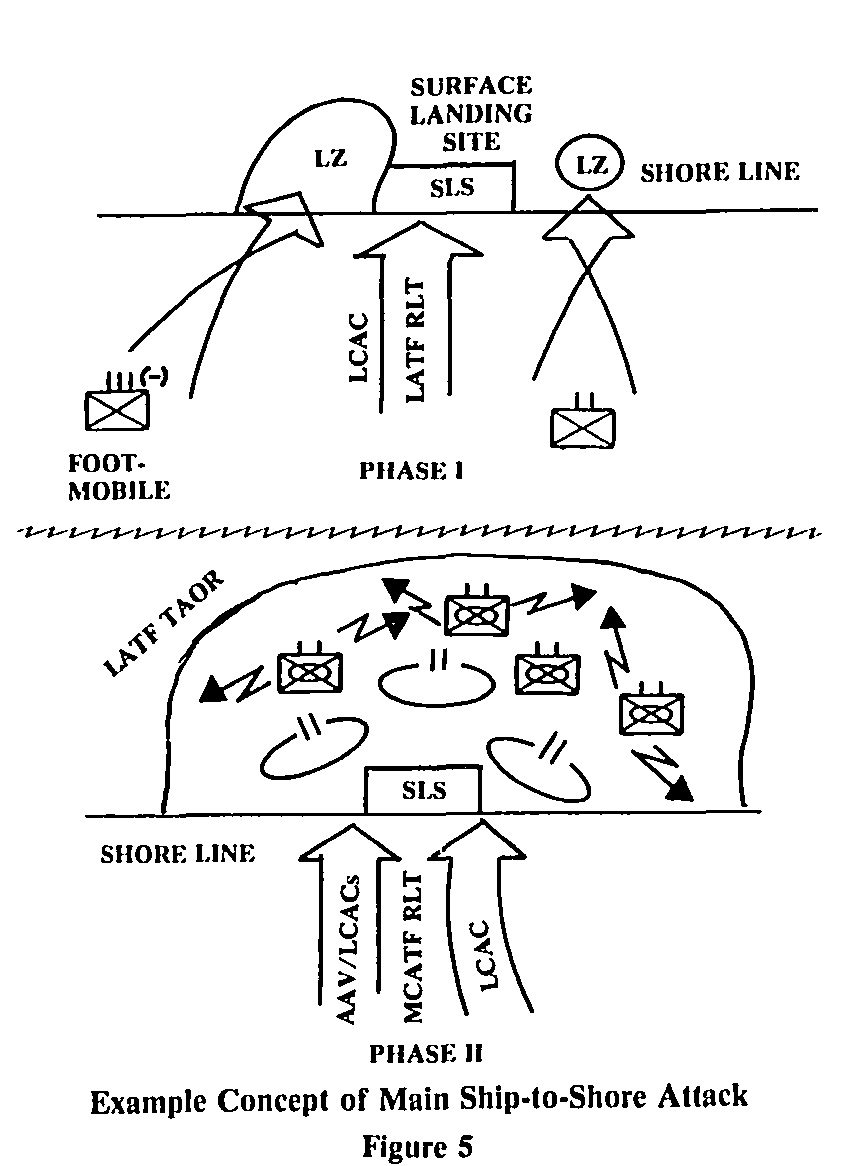
An example of the main ship-to-shore attack is illustrated in Figure 5. Depending on the “situation and terrain,” the lighter RLTs are landed to ensure control of the surface landing site in preparation for the on-call landing of the MCATF RLT. Although the LCAC-landed RLT may be landed at H-hour when one is sure of an unopposed touchdown, the more common technique would probably be to land the helicopterborne forces first to ensure an unopposed LCAC landing.
In order to further illustrate the flexibility and complementary nature of the heavy-lift helicopter and LCAC combined with a LATF/foot-mobile mix, envision a night landing in which on-site, covert reconnaissance has verified an undefended surface landing site. At the risk of preaching to the choir, note the LCAC force could be landed first to secure nearby LZs to ensure their security for the touchdown of the helicopterborne force.
A second phase of the attack is characterized by the unopposed landing of the heavy MCATF RLT. As envisioned here, the normal concept would involve (1) LCACs return to the shipping (which has closed somewhat from the original launch area) to pick up the second lift, the tank battalion; (2) on-call, orchestrated launch of three mechanized battalions in AAVs and the tank battalion in LCACs. Underway launch of the AAVs is conducted as close to the landing site as possible. Which lands first, the AAVs or LCACs, is a function of the specific situation, not a function of doctrine. The only doctrinal tenet envisioned here is that LCAC and AAV waves are not mixed. Upon landing, the mechanized infantry and tank units proceed to assembly areas or preattack positions in accordance with predetermined cross-attachment orders; (3) LCACs return to the shipping to bring in the third lift, self-propelled artillery attached to, or in direct support of, the MCATF RLT.
Before leaving the main ship-to-shore attack, it is appropriate to reflect on the basic complementary nature of the LCAC/AAV equation. In projecting the heavy MCATF RLT ashore, the fundamental goal is to land the ground maneuver elements of the entire RLT intact-one lift-with the tactical integrity required to begin maneuver or execute task force mission assignments shortly after landing. Piecemeal buildup of the MCATF ashore is unacceptable in light of the capabilities of the expected enemy-therefore, the basic nature of the equation is the simple logic of quantity.
The primary problem in the early stages of operations ashore is to expand the maneuver area against a numerically superior enemy (step 4). Although specific tactics would vary greatly, two general examples will be used to show potential contrasts in tactical techniques.
The first example is illustrative of a situation where forces have landed relatively far from major enemy units (See Figure 6.) In this case, expansion of the area is achieved rapidly through offensive action. The action could be either recon-pull or command-push. In most cases, it would attempt to expand the maneuver area along the littoral to a greater distance than expansion inland. In the illustration, note (1) the mobile reconnaissance screen, (2) combined vertical/two-dimensional attack of the LATF RLT, and (3) the retention of one maneuver battalion of the MCATF RLT as division reserve.
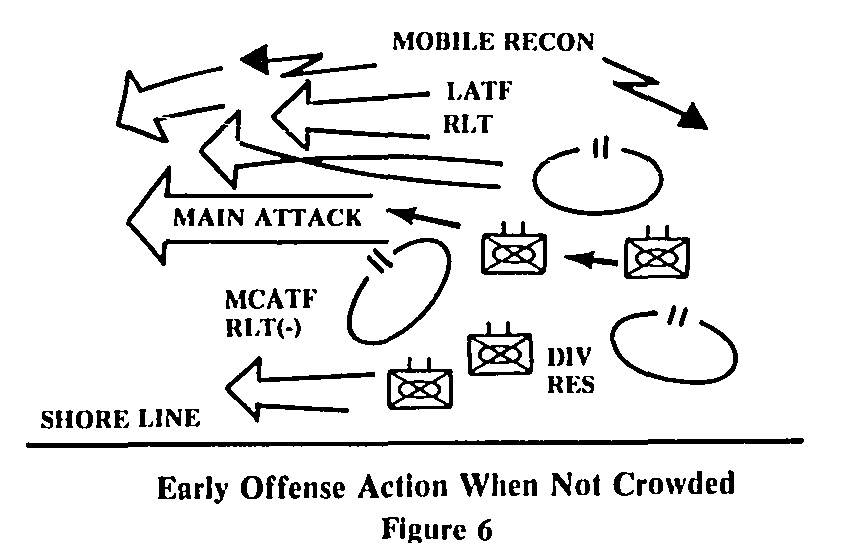
The second example is illustrative of situations in which major enemy elements are relatively close to the landing area. In this case, the basic concept is designed to focus on one fundamental of amphibious warfare: the shoreline is a natural and insurmountable obstacle to the enemy. With the landing force no longer tied to a NIS-type beach and a vulnerable beach support area (BSA), the shoreline offers a distinct advantage; the maneuver area of the landing force extends seaward; that of the enemy does not. Figure 7a depicts the general unit dispositions. The MCATF RLT is in a TAOR with the mission of delaying and canalizing an enemy attack toward the shoreline. The foot-mobile RLT occupies major ambush/blocking positions in restricted terrain. The LATF is the division reserve located in an area which would be a logical objective of the main enemy attack, or the shoreline terminus of a major corridor to the coast. In Figure 7b, reconnaissance elements and the MCATF RLT conduct ambush and delaying actions to impede progress of units in the shoulder of the attack while permitting more rapid progress in the center. During this phase, some enemy units are drawn toward a major ambush (temporary blocking) position in restricted terrain where a foot-mobile BLT extracts a toll and withdraws under the cover of MCATF ambushes and/or limited counterattacks. The LATF is extracted by helicopter and redeployed either deep on an exposed flank or near the rear of the enemy force. It attacks selected elements of the enemy force using hit and run tactics. The LATF might be redeployed by helicopter several times during this period; it could also be extracted in some situations.
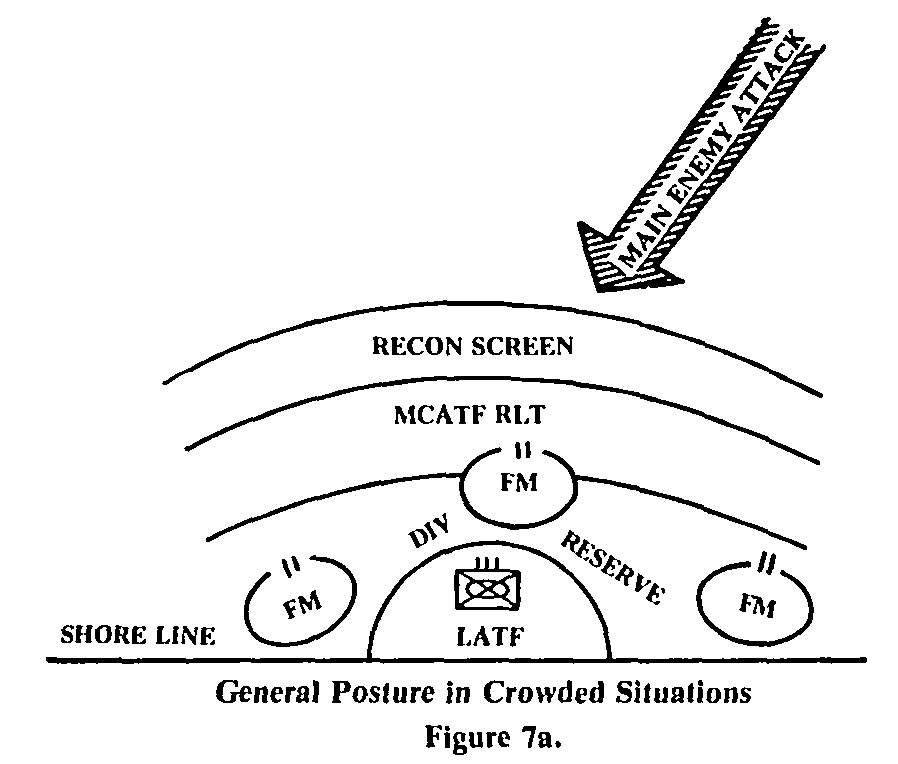
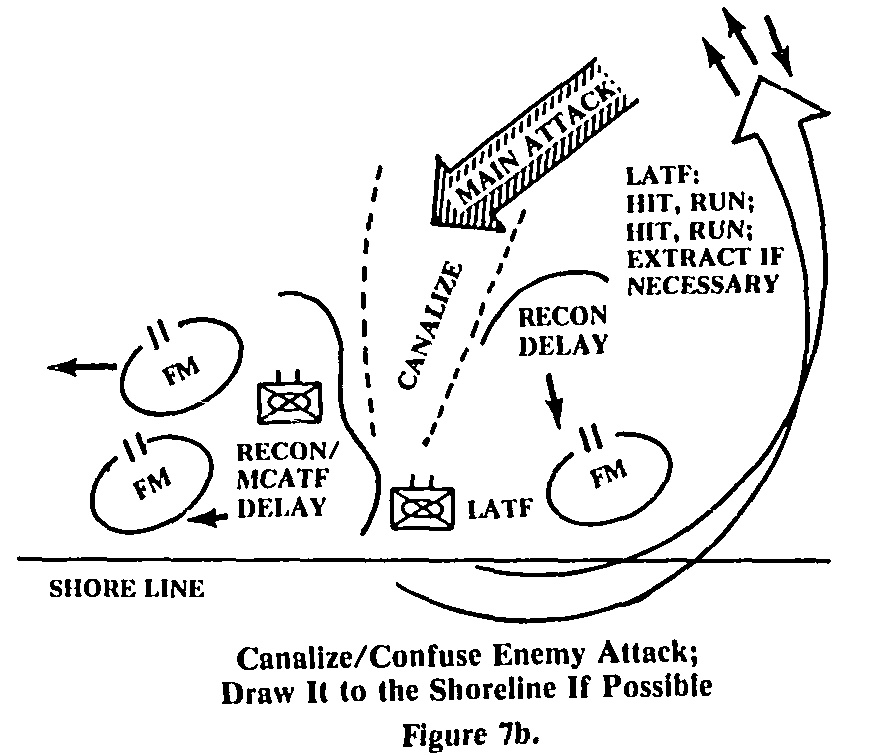
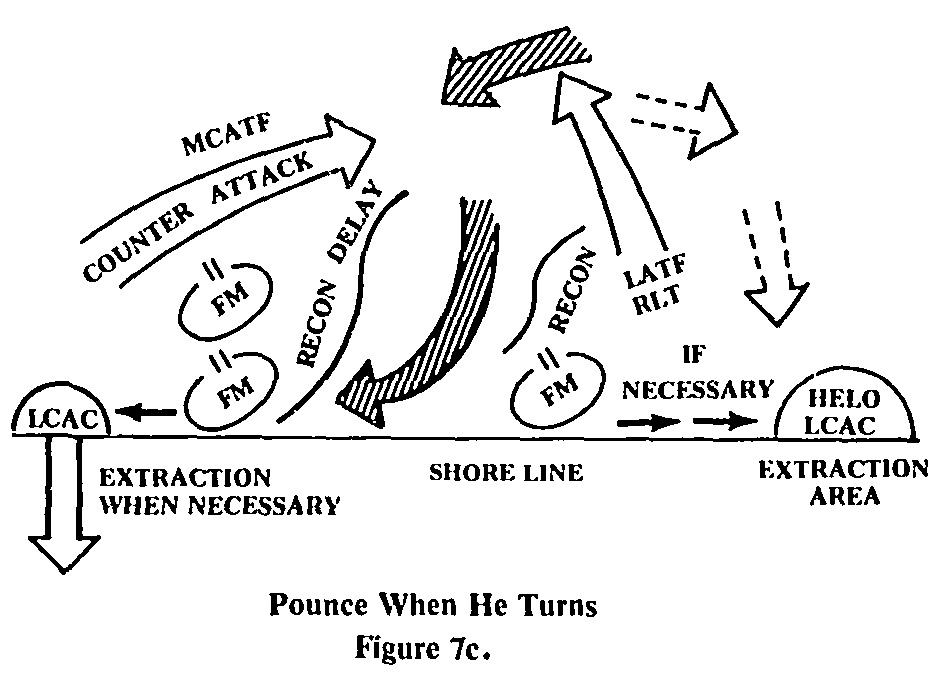
In Figure 7c, we see that when the enemy attack approaches or hits the shoreline, it must stop or turn. In either event, it becomes most vulnerable. Should it turn in the anticipated direction as indicated in the figure, it will be drawn toward restricted terrain and the MCATF will counterattack in conjunction with a deep thrust by the LATF. Should the enemy turn in the opposite direction, the lighter forces withdraw toward a helo/LCAC extraction area, and at the right moment, the MCATF RLT attacks into the rear of the enemy force. In such case, the extracted forces would be redeployed to support the MCATF attack.
These illustrations should suffice to begin to picture a maneuver style of warfare for future landing forces. Wild?-Maybe not. Exaggerated?-Yes, to illustrate principles and the contrast with conventional landing doctrine, but not beyond possibility if we prepare for it.
Conclusion
This article is essentially a roadmap toward a maneuver style of warfare for landing forces. Evolving the doctrine, tactics, and techniques which would define the Marine Corps’ roadmap is your challenge.




